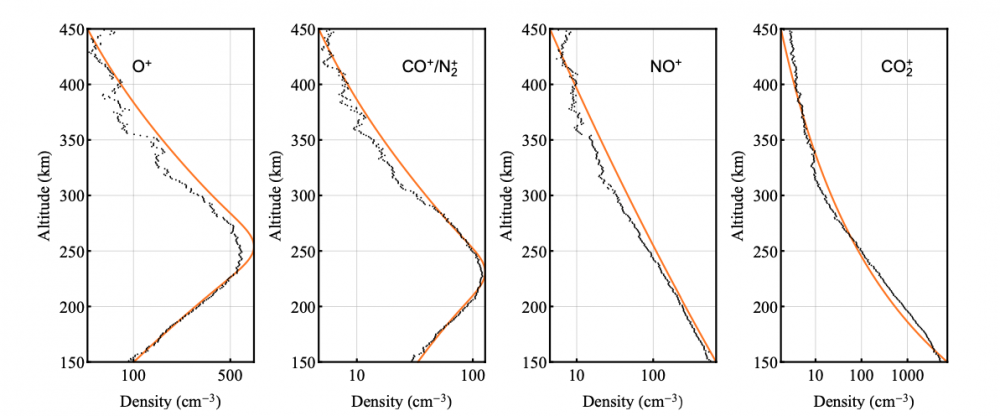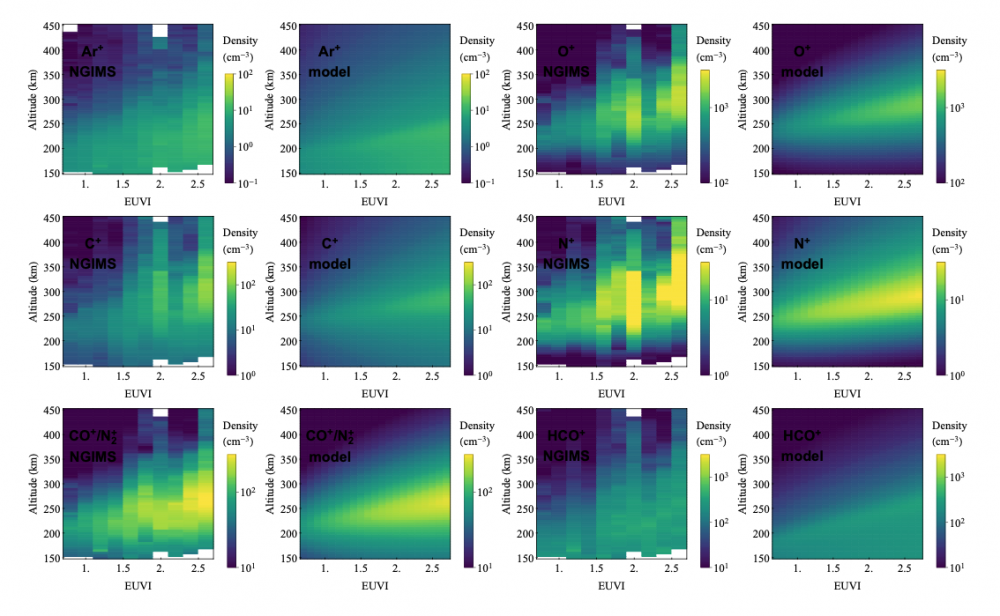Empirical models of ion density distribution in the dayside Martian ionosphere
With the aid of the recent Neutral Gas and Ion Mass Spectrometer (NGIMS) measurements made onboard the Mars Atmosphere and Volatile Evolution spacecraft, we construct empirical models for the vertical density distributions of 12 species in the dayside Martian ionosphere over the altitude range of 150-450 km, from abundant species such as O2+, CO2+, and O+ to trace species such as HO2+ and OCOH+. Two different sets of formulism are proposed to parameterize the ion density distribution characterized either by a distinctive layer structure or by a near exponential decay above 150~km. Both the solar control and magnetic control of ion distribution are taken into account in our modelings. In general, our empirical models are in good agreement with the NGIMS measurements. The full set of parameters constrained by data-model comparison is tabulated for reference.

The best-fit parameters are constrained by data-model comparison for each species. These parameters allow an easy computation of any individual ion distribution in the dayside Martian ionosphere up to SZA~75o, over the solar energy flux range of 0.56-2.16 mW m-2 (or equivalently the 10.7 cm solar radio index range of 18-73 SFU at Mars), as well as over the range of ambient magnetic elevation from horizontal to vertical.
The empirical models reported here are an extension of existing empirical models of electron distribution in the dayside Martian ionosphere Detailed data-model comparisons indicate that our empirical models reproduce reasonably the NGIMS-derived variations of ion density with altitude, SZA, incident solar flux, and magnetic elevation characterized by an average 50% percentile of 63%. A further comparison between our model results and those from the most recent electron density model of Nemec et al., 2019 constructed from the available MEx MARSIS data suggests a discrepancy between them in that the total ion density predicted by our model is systematically lower than the electron density predicted by the Name et al., 2019 model.Such a discrepancy could be partly due to different instrument uncertainties and partly due to different sampling biases.
The empirical models reported here help to fill the ``gap" in data sampling, extending the ion density variations to regions not well sampled by the available NGIMS measurements such as regions at low SZAs and simultaneously illuminated by low solar fluxes. Finally, we caution that extra sources of ionospheric variability such as the condition of the background atmosphere are ignored for simplicity and left for follow-up investigations when more NGIMS data are accumulated.

The article has been accepted by JGR-Space Phyics. All Methematica codes for generating the empirical models can be accessed via Zenodo (https://doi.org/10.5281/zenodo.5784927).
References:
Nemec, F., Morgan, D. D., Kopf, A. J., Gurnett, D. A., PitoAak, D., Fowler, C. M.,Andersson, L. (2019, January). Characterizing Average Electron Densities in the Martian Dayside Upper Ionosphere. Journal of Geophysical Research (Planets), 124(1), 76-93. doi: 10.1029/2018JE005849

